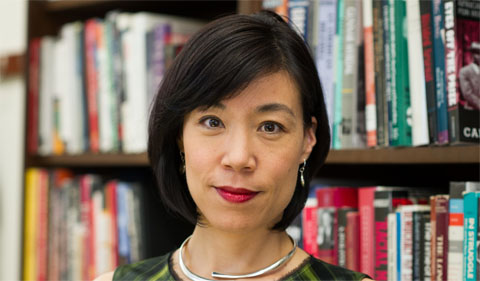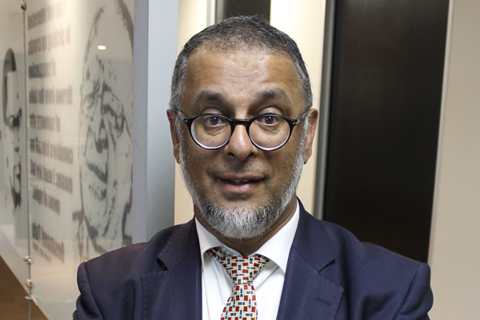
Dr. Naomi Murakawa
This is the text of Ohio University’s 2017 Constitution Day Lecture, delivered by Dr. Naomi Murakawa on Sept. 28, 2017 at the Athena Theater in Athens, Ohio. Murakawa is Associate Professor of African American Studies at Princeton University. Constitution Day is hosted by The Center for Law, Justice & Culture at Ohio University.
An Open Letter to the Baker Seventy
Naomi Murakawa
On the evening of Feb. 1, 2017, roughly 300 protesters gathered at the Athens County Courthouse to protest Donald Trump’s first executive order banning immigration from seven Muslim-majority countries. The group of protesters, dropping off some in numbers, were flanked by police as they then marched to Ohio University’s Baker Center. Occupying the Rotunda area of the Baker Center, the protesters called for University officials to meet with them to discuss the possibility of OU becoming a sanctuary campus.
At approximately 7:20 pm, Ohio University Police Chief Andrew Powers warned that anyone who did not immediately leave the Rotunda would be arrested. He was good on his promise: at 7:58 pm, police began arresting, 70 students in total, charged with criminal trespass. Of these, 15 students accepted the plea bargain of “disorderly conduct.” The remaining waited for trial, but most of the charges were dropped after The Athens County Municipal Court, with Judge Todd Grace presiding, found the first of 55 defendants (Michael Mayberry) not guilty of criminal trespass.
Judge Grace reasoned that Mr. Mayberry engaged in Constitutionally protected speech, and — this is the pivotal part — Judge Grace held that the Baker Center is in fact a Designated Public Forum, where the government opens a piece of state property to the public at large, treating it as if it were a traditional public forum space like a park or a sidewalk. As a Designated Public Forum, any regulation on speech (like arresting someone for criminal trespass) is subject to strict scrutiny, must serve a compelling interest, and must be narrowly drawn.
In response, on August 17 Ohio University approved interim policy 24.014, the so-called Freedom of Expression policy, which begins with a clarification of the protected realms of speech and then goes on to prohibit “demonstrations, rallies, public speechmaking, picketing, sit-ins, marches, protests and similar assemblies” from taking place inside university buildings. Had this policy been in place in February 2017, then there would have been a clean legal pathway for finding the Baker protesters guilty of criminal trespass.
In light of these events, I wrote this Constitution Day lecture as an open letter to the to the Baker 70 all who protested on that February night.
I want to start by thanking you for standing up to the forces of racial criminalization that dominate our times. In demanding that Ohio University become a “sanctuary campus,” you tried to disentangle the university from Immigration and Customs Enforcement (ICE), one of the most pernicious and powerful institutions of racial criminalization. Here I should clarify that when I speak of racial criminalization in our times, the time I am referring to long precedes President Trump. It is, of course, right to protest President Trump’s attempts to radically restrict all immigration, to ban immigration from Muslim-majority countries, and to build a wall on the southern border, especially when he justifies these proposals with the kind of false, incendiary statements that fueled his campaign. But, as you know, President Trump’s horrible words were, in millions of ways, already licensed by President Obama’s horrible actions, as Obama presided over the expansion of ICE and the deportation of 2.5 million people.
In February 2017, you stood up to racial criminalization and asked your university to stand with you. In response, you were subjected to the routine machinery of the criminal justice system, a machinery that has developed through precisely the logics of the racism and xenophobia that you were protesting. In the United States penal democracy, there are 2.2 million people in prison and jail. This represents a 500 percent increase since the passage of the Civil Rights Act of 1964. Of the imprisoned, sixty percent are people of color. Every year police make between 10 and 12 million arrests; less than 5 percent are for violent crimes; and 26 percent of arrests are of black people, twice their proportion in the population.
The charge you faced was “criminal trespass.” The history of trespass is long, but in the second half of the twentieth century, lawmakers expanded trespass to contain “criminals” who are now rightly regarded as heroes. When African-American students sat at a segregated Woolworth lunch counter in Greensboro, North Carolina, in 1960, they ignited a sit-in movement in which hundreds were arrested on charges of criminal trespass. Given that the black freedom struggle demanded jobs and justice, seeing economic freedom and racial liberation as inextricably linked, it seems unsurprising that these same criminal trespass statutes have also been deployed against union organizers. Many Native Americans who protested the pipeline at Standing Rock were arrested and charged with trespassing onto what is, in every sense, their land.
The story of trespass is also the story of punishing the poor for so selfishly existing in plain public view. City-level lawmakers used trespass more and more through the 1980s and 1990s, as people became uncomfortable witnessing the consequences of sustained policies of economic immiseration, including the upward redistribution of wealth, and defunded social and health services. The consequences of these policies were visible all over the city landscape — many people who do not have steady employment stand in certain places hoping to get picked up as a day laborer; many people who don’t have homes spend their days and nights in certain parks; many people who don’t have money sit in certain shopping districts and ask for change. Rather than address human need, city leaders criminalized it.
In short, every part of this story — all that you protested, and all you endured — is connected to criminalization and inequality. Yet aren’t you all just a little irritated that the conversation is now focused only on the question of free speech?
To be clear, I believe that your University’s interim “Freedom of Expression” policy is indeed an overbroad, unnecessary encroachment on freedom of assembly and speech. It deserves all the disapproval it has received. The Students for Law, Justice & Culture rightly fault the policy for giving the University “blanket permission to restrict and punish student expression as it sees fit.” Professor Bernhard Debatin calls it “an embarrassment and a scandal.” Even the name, “Freedom of Expression Policy,” has the shrill dissonance of double-speak.
Now that I have registered my opposition to the interim policy, let me clarify why I would feel irritated about this topical switch from criminalization and inequality to free speech. In the penal democracy, we do not have a well-developed common language for talking about the structural violence of racial capitalism. In the same way that I am grateful to the Baker 70, I am grateful to Black Lives Matter, Dreamers, Occupiers, feminists, socialists, and anti-war activists for forcing the conversation. And when activists do us the great service of naming and fighting structural violence, often they are met with overt repressive violence. But it is also chilling when they are met by all those who think of themselves as the even-handed, order-loving moderates, those who proudly self-identify as the reasonable middle, who take this analysis of structural violence, strip it down into composite parts, sell off the structural part, twist the critique of systemic violence into the law-and-order fetish for safety, and then claim to support the decontextualized, defanged, little proposal that remains.
A second form of pseudo-support for justice is standing up for free speech, and thinking that’s enough. Rather than only talk of free speech, I hope that the conversation can return to where it began — to the crucial question of the university’s connection to criminalization. There is a tendency for free speech frameworks to slip into the realm of abstractions and hypotheticals. And rather than turn to abstractions and hypotheticals, I want us to situate the “Freedom of Expression” policy in the brass tacks — what it actually does, how it has been justified, and what happens if it is transgressed.
What we see is very simple and completely in line with order-maintenance policing, the idea that small signs of disorder will lead to a culture of chaos and decline. That is, this policy is the prohibition of nonviolent behavior, justified on grounds that nonviolent behavior creates the conditions of possibility for violence. And how is the prohibition enforced? If the recent history of February 1 is our guide, then it is enforced through the coercive and routinely violent apparatus of the criminal justice system.
You in the Baker Seventy and the February 1 protesters demanded that the University separate itself from immigration enforcement, which is central to the prison industrial complex. That is the demand that must be silenced now.
I know it might not feel like it, but the fact that the University had to pull this kind of nonsense over the summer is actually a sign of something amazing, something I hope you won’t forget: By working collectively, by organizing, by standing up for what’s right, someone worried that you might win. Remember this. Keep it close. Keep going.



















Comments